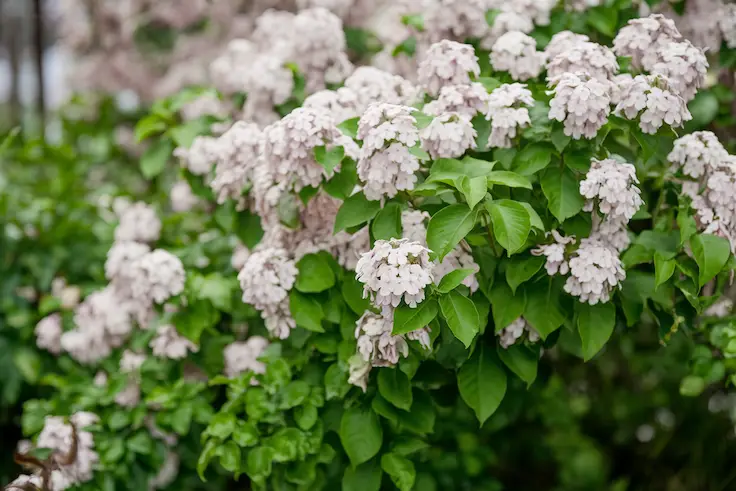Biological Features of New Jersey Tea Plant
The New Jersey tea plant, also known as Ceanothus americanus, exhibits unique biological characteristics. This deciduous shrub typically reaches heights of 3 to 4 feet. Its leaves are dark green, and they grow in an alternate arrangement. Additionally, the plant features clusters of tiny, white to pale blue flowers.
Leaf Characteristics
The leaves of the New Jersey tea plant are oval-shaped, measuring 2 to 4 inches long. They possess finely serrated edges, enhancing the plant’s aesthetic appeal. The leaf structure also serves a vital role in photosynthesis, allowing efficient energy capture.
Flowering and Pollination
This plant blooms during late spring to early summer. The flowers are not only beautiful but also attract various pollinators, including bees and butterflies. This process plays a crucial role in maintaining ecological balance.
Growth Conditions
The New Jersey tea plant thrives in well-drained soils, typically preferring sandy or loamy textures. It requires full sun to partial shade for optimal growth. Moreover, it is drought-tolerant, making it suitable for xeriscaping in gardens.
| Feature | Description |
|---|---|
| Height | 3 to 4 feet |
| Leaf Shape | Oval, 2 to 4 inches long |
| Flower Color | White to pale blue |
| Bloom Time | Late spring to early summer |
| Soil Preference | Well-drained, sandy or loamy |
| Sunlight Needs | Full sun to partial shade |

History and Cultural Significance
The New Jersey tea plant, known scientifically as Ceanothus americanus, has a rich history intertwined with American culture. This native shrub gained importance during the Revolutionary War. Its leaves were brewed as a tea substitute when traditional tea was scarce due to British blockades. This usage helped foster a sense of independence among early Americans.
Native American Uses
Native Americans recognized the value of the New Jersey tea plant long before European settlers arrived. They utilized the plant for various medicinal properties. The leaves were used to treat ailments like coughs and sore throats. Additionally, it served as a dye source to color fabrics, showcasing its multifunctionality.
Modern Cultural Relevance
In contemporary times, the New Jersey tea plant has found a place in landscaping and gardening. Its low, spreading habit makes it ideal for erosion control. Gardeners appreciate its drought-resistant qualities, which contribute to sustainable gardens. The plant also attracts pollinators, particularly bees and butterflies, enhancing biodiversity.
Ecological Importance
Furthermore, the New Jersey tea plant plays a significant role in its ecosystem. It provides habitat and food sources for numerous wildlife species. The plant’s nitrogen-fixing capabilities enrich the soil, benefiting surrounding flora. Notably, it also serves as a vital component of the Mid-Atlantic native plant community.
Key Points to Note
- Serves as a tea substitute during the Revolutionary War.
- Used medicinally by Native Americans.
- Ideal for sustainable landscaping due to drought resistance.
- Supports local wildlife and biodiversity.
- Important part of the native plant community.

Ideal Growing Conditions for New Jersey Tea Plant
The New Jersey tea plant thrives under specific conditions. Proper care can enhance its growth and flowering. Begin with adequate sunlight. This plant prefers full sun to partial shade, ideally receiving at least six hours of sunlight per day. If too much shade is present, growth may be stunted.
Soil Requirements
Next, consider the soil type. New Jersey tea plants require well-drained soil with a slightly acidic to neutral pH. They prefer sandy or loamy soil. Amend the soil with organic matter to improve drainage and nutrient content. Good drainage is critical to prevent root rot.
Watering Needs
The New Jersey tea plant has moderate watering needs. Once established, it is somewhat drought-tolerant. However, during periods of dry weather, watering is necessary. Ensure that the top inch of soil dries out before watering again. Overwatering can lead to fungal issues.
Temperature and Humidity
This plant is hardy in USDA zones 3 to 9. It prefers temperatures between 60°F and 75°F (15°C to 24°C). In extremely hot or cold conditions, some protection may be necessary. Adding mulch around the base can help insulate the roots and retain soil moisture.
| Aspect | Ideal Conditions |
|---|---|
| Sunlight | Full sun to partial shade |
| Soil Type | Well-drained, sandy or loamy |
| Soil pH | Slightly acidic to neutral |
| Watering | Moderate; allow to dry between waterings |
| Temperature | 60°F to 75°F |
| USDA Hardiness Zone | 3 to 9 |
In summary, to cultivate a healthy New Jersey tea plant, provide the right balance of sunlight, water, and soil conditions. By adhering to these ideal conditions, you can ensure a thriving, beautiful plant.

Plant Care and Maintenance
The New Jersey tea plant requires specific care to thrive. This deciduous shrub prefers well-draining soil and full to partial sunlight. It can tolerate a range of soil types, although it flourishes in sandy or loamy conditions. Moreover, ensuring proper drainage is critical as the roots can rot in overly soggy soil.
Watering Requirements
When it comes to watering, consistency is vital. Generally, the New Jersey tea plant should be watered weekly during dry spells. However, adjust the frequency based on rainfall. On average, aim for about an inch of water per week. Always check the soil moisture before watering to avoid over-saturation.
Fertilization
Fertilization is essential to promote healthy growth. During the growing season, apply a balanced, slow-release fertilizer. This can be done in early spring. Follow the package instructions for the correct amount. Over-fertilization can actually harm the New Jersey tea plant.
Pruning
Pruning helps maintain the shape and encourages new growth. It’s best to prune in late winter or early spring before new growth begins. Remove any dead or damaged branches to keep the plant healthy. Additionally, thinning out crowded areas allows better airflow and reduces disease risk.
Pest Management
Pests can occasionally be a concern. Common pests include aphids and spider mites. Monitor your plant regularly for signs of infestation. If found, treat them with insecticidal soap or neem oil. This method is effective and safe for the environment.
Winter Care
During winter, protecting the New Jersey tea plant from harsh conditions is important. Mulching around the base can help insulate the roots. Additionally, provide some shelter from extreme winds and cold. These measures will ensure your plant survives winter and thrives in spring.
Key Points for Successful Care
- Well-draining soil is essential.
- Water consistently but avoid over-watering.
- Apply fertilizer during the growing season.
- Regular pruning promotes health and vigor.
- Monitor for pests and treat promptly.
- Provide winter protection with mulch.
By following these guidelines, your New Jersey tea plant can flourish and remain a beautiful addition to your garden.

Propagation Techniques for New Jersey tea plant
The New Jersey tea plant, also known as Ceanothus americanus, is relatively easy to propagate. It can be grown from both seeds and cuttings. Start by collecting seeds in late summer or early fall when they are fully matured. Soak them in water for 24 hours before planting. This soaking technique enhances germination rates significantly.
In terms of soil, choose well-draining material that retains some moisture but does not become waterlogged. A mixture of sand and peat moss is often ideal. Next, sow the seeds about 1/4 inch deep in the soil. Water the area gently to avoid displacing the seeds.
If you prefer using cuttings, late spring is the best time to take them. Select healthy shoots and cuttings that are at least 3-4 inches long. Remove the lower leaves to prevent rotting. Dip the cut end in rooting hormone, as this can speed up the process. Plant the cuttings in a mixture of perlite and peat moss for optimal growth.
Keep the soil consistently moist but not soggy during the rooting phase. Using a clear plastic bag as a mini greenhouse can help maintain humidity. This practice aids in creating suitable conditions for the cuttings to develop roots. After about six weeks, check for root development by gently tugging on the cuttings.
Once rooted, transplant the new plants into pots with appropriate soil. Ensure they receive adequate sunlight, ideally six hours a day. Regularly inspect for pests like aphids which may affect their growth. The New Jersey tea plant is resilient and can adapt to various conditions, making propagation rewarding.
In summary, whether you opt for seeds or cuttings, the key lies in maintaining optimal moisture and light conditions. Following these techniques will surely help you cultivate healthy New Jersey tea plants.
Common Problems and Solutions
The New Jersey tea plant can face several issues throughout its life cycle. Understanding these problems and their solutions is crucial for maintaining healthy growth. This guide focuses on common challenges and effective remedies.
Pests and Diseases
Pests such as aphids and spider mites may invade the New Jersey tea plant. These pests feed on the plant’s sap, leading to stress and decreased vitality. To combat these pests, regularly inspect the leaves for signs of infestation. Consider using insecticidal soap or neem oil as a natural remedy.
Environmental Factors
Environmental stress can significantly affect the growth of the New Jersey tea plant. Overwatering is a common issue that can lead to root rot. Conversely, insufficient watering can cause wilting and poor health. Ensure your plant has well-draining soil, and water only when the top inch of soil feels dry. Aim for consistent moisture without waterlogged conditions.
Soil and Fertilization
The New Jersey tea plant thrives in well-draining, nutrient-rich soil. Poor soil quality can lead to stunted growth and nutrient deficiencies. Regularly amend the soil with organic matter, such as compost, to promote healthy growth. Fertilizing once in the spring with a balanced fertilizer will also enhance vigor.
Common Symptoms
Recognizing symptoms of distress is essential for treatment. Look for yellowing leaves, stunted growth, or wilting. Each symptom can indicate different issues, so diagnosing correctly is key. Below is a list of common symptoms and their potential solutions:
- Yellowing Leaves: This can signal nutrient deficiencies, typically nitrogen. Increase fertilization or amend the soil to restore balance.
- Wilting: Over or under-watering could be the culprit. Check the soil moisture level and adjust your watering schedule.
- Stunted Growth: This may occur due to insufficient light or poor soil conditions. Ensure the plant receives adequate sunlight and consider repotting.
Preventative Measures
To prevent issues with your New Jersey tea plant, maintain a regular care routine. Monitor water levels, inspect for pests, and ensure proper nutrition. By being proactive, you can avert many common problems, leading to a thriving plant.
| Problem | Symptoms | Solution |
|---|---|---|
| Pests | Discolored leaves | Insecticidal soap |
| Overwatering | Wilting | Reduce watering |
| Soil Issues | Stunted growth | Soil amendment |
Seasonal Care Adjustments
The New Jersey tea plant requires specific care adjustments throughout the seasons. This ensures optimal growth and blooming. Spring is the time for rejuvenation. Begin by trimming back old growth to stimulate new shoots. Regular watering becomes essential as plants awaken from dormancy. Use a balanced fertilizer to boost growth. Transitioning into Summer, maintain consistent moisture. The New Jersey tea plant thrives in well-draining soil, so avoid waterlogged conditions. Mulching can help retain soil moisture while also suppressing weeds. Autumn brings a time for preparation. As temperatures cool, reduce watering frequency. This helps the plant acclimate for winter. Be sure to clear away fallen leaves and any debris around the base. In Winter, minimize disturbance. If temperatures drop significantly, consider providing shelter to protect plants from frost. The New Jersey tea plant prefers a dry winter environment.
- Trim back old growth in spring.
- Ensure consistent watering in summer.
- Reduce watering in autumn.
- Protect from frost in winter.
Microclimate Setup Tips
Creating the perfect microclimate for the New Jersey tea plant requires attention to detail. Start by selecting an area with good sunlight exposure. Ideally, the plant needs at least six hours of direct sunlight daily. When choosing a location, consider the surrounding structures. These can provide shade or wind protection, enhancing the plant’s growth.
Soil and Watering Considerations
New Jersey tea plants thrive in well-drained, sandy soil. You can enhance drainage by mixing organic materials like compost or peat moss into the soil. Watering is crucial, especially during dry spells. Aim to keep the soil consistently moist but not waterlogged.
Temperature and Humidity
This plant prefers a moderate climate. It tolerates a range of temperatures but thrives in 60°F to 75°F. Ensure proper humidity levels to mimic its natural environment. Adding mulch can help maintain moisture and regulate soil temperature.
Additionally, monitor wind exposure. High winds can stress the plant, leading to poor growth. Windbreaks can help create a more favorable environment.
- Choose a sunny location.
- Use well-drained soil.
- Water consistently without overwatering.
- Maintain moderate temperatures.
- Provide protection from high winds.
Frequently Asked Questions
The New Jersey tea plant, scientifically known as Ceanothus americanus, is often surrounded by various queries. This plant is well-loved for its hardiness and ability to thrive in different environments. Gardeners frequently ask about its care requirements. The New Jersey tea plant prefers sandy or loamy soil that drains well. Regular watering is essential, especially in dry periods. However, it’s important to avoid overwatering.
Another common question pertains to its growth rate. The New Jersey tea plant typically grows slowly, reaching full maturity in about three years. Many ask how to propagate it. This can be achieved through seed or cuttings, with seeds requiring a cold stratification period for best results.
People also inquire about its pest and disease resistance. Fortunately, the New Jersey tea plant is largely disease-resistant and attracts few pests. Occasionally, some gardeners may notice aphids, which can be managed naturally. Lastly, the plant’s use in landscaping is popular due to its beautiful blue flowers and ability to attract pollinators.
Summary and Recommendations
The New Jersey tea plant is celebrated for its unique characteristics and ecological value. This native shrub thrives in well-drained soil and prefers sunny locations. Its lovely white flowers attract pollinators, making it a valuable addition to gardens and landscapes.
For optimal growth, ensure regular watering, especially during dry spells. Fertilizing should be done in early spring to support healthy development. Additionally, pruning can enhance its shape and flowering potential. Overall, the New Jersey tea plant is a low-maintenance choice for gardeners.
Consider incorporating this plant into your garden not just for its beauty but also for its role in attracting beneficial insects. Overall, planting New Jersey tea contributes positively to local biodiversity.






